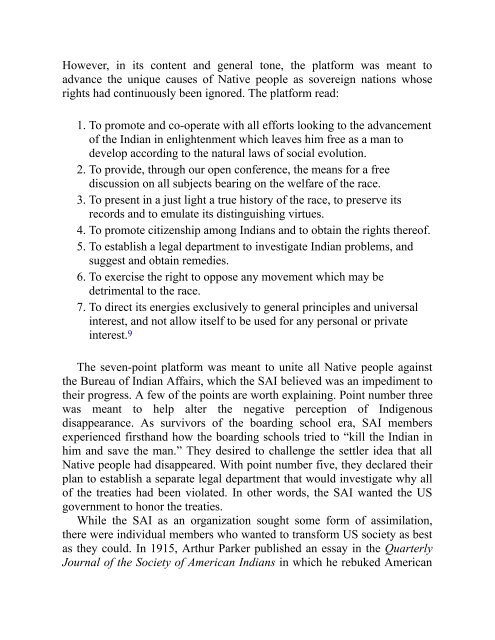You also want an ePaper? Increase the reach of your titles
YUMPU automatically turns print PDFs into web optimized ePapers that Google loves.
However, in its content and general tone, <strong>the</strong> platform was meant to<br />
advance <strong>the</strong> unique causes <strong>of</strong> Native people as sovereign nations whose<br />
rights had continuously been ignored. The platform read:<br />
1. To promote and co-operate with all efforts looking to <strong>the</strong> advancement<br />
<strong>of</strong> <strong>the</strong> Indian in enlightenment which leaves him free as a man to<br />
develop according to <strong>the</strong> natural laws <strong>of</strong> social evolution.<br />
2. To provide, through our open conference, <strong>the</strong> means for a free<br />
discussion on all subjects bearing on <strong>the</strong> welfare <strong>of</strong> <strong>the</strong> race.<br />
3. To present in a just light a true history <strong>of</strong> <strong>the</strong> race, to preserve its<br />
records and to emulate its distinguishing virtues.<br />
4. To promote citizenship among Indians and to obtain <strong>the</strong> rights <strong>the</strong>re<strong>of</strong>.<br />
5. To establish a legal department to investigate Indian problems, and<br />
suggest and obtain remedies.<br />
6. To exercise <strong>the</strong> right to oppose any movement which may be<br />
detrimental to <strong>the</strong> race.<br />
7. To direct its energies exclusively to general principles and universal<br />
interest, and not allow itself to be used for any personal or private<br />
interest. 9<br />
The seven-point platform was meant to unite all Native people against<br />
<strong>the</strong> Bureau <strong>of</strong> Indian Affairs, which <strong>the</strong> SAI believed was an impediment to<br />
<strong>the</strong>ir progress. A few <strong>of</strong> <strong>the</strong> points are worth explaining. Point number three<br />
was meant to help alter <strong>the</strong> negative perception <strong>of</strong> <strong>Indigenous</strong><br />
disappearance. As survivors <strong>of</strong> <strong>the</strong> boarding school era, SAI members<br />
experienced firsthand how <strong>the</strong> boarding schools tried to “kill <strong>the</strong> Indian in<br />
him and save <strong>the</strong> man.” They desired to challenge <strong>the</strong> settler idea that all<br />
Native people had disappeared. With point number five, <strong>the</strong>y declared <strong>the</strong>ir<br />
plan to establish a separate legal department that would investigate why all<br />
<strong>of</strong> <strong>the</strong> treaties had been violated. In o<strong>the</strong>r words, <strong>the</strong> SAI wanted <strong>the</strong> US<br />
government to honor <strong>the</strong> treaties.<br />
While <strong>the</strong> SAI as an organization sought some form <strong>of</strong> assimilation,<br />
<strong>the</strong>re were individual members who wanted to transform US society as best<br />
as <strong>the</strong>y could. In 1915, Arthur Parker published an essay in <strong>the</strong> Quarterly<br />
Journal <strong>of</strong> <strong>the</strong> Society <strong>of</strong> American Indians in which he rebuked American


















